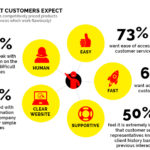
INTRODUCTION
Customer service usually involves multiple touch points. For example, contact with customers could include providing an update on when a delivery or service is expected to arrive. With multiple touch points for just one transaction, you have multiple opportunities to safeguard customer satisfaction.
When you operate a fleet, vehicles and drivers are extensions of your business. A vehicle breakdown, for example, could equate to a late arrival for a service call, a lost customer and even reputation damage if that customer shares their experience.
Fleet management solutions can help eliminate time-wasting tasks surrounding your fleet so you can focus on the bottom line for delivering better customer service.
Below are five ways a fleet management solution can help improve customer service and strengthen your business.
Improve billing and communication with the help of GPS tracking
Depending on your type of business, accurate location data for each driver can be an important step in providing customers with correct and timely billing information.
Visibility over how long a driver is at a job, how that aligns with timecards or time billed, and the actual GPS data helps you provide complete transparency to your customers. Should a dispute arise, you have time-stamped locations that can help answer customer concerns. You’ll be able to have the right conversation—and promptly—to help maintain customer satisfaction.
Fleets can also use geofencing within GPS tracking, which allows fleet managers to set customizable boundaries for drivers. This can help prevent inflated bills by curbing misuse of company time.
Exceeding customer expectations not only satisfies each customer, but can also attract new business if that customer speaks highly of your service. Promptly resolving customers’ concerns is one way to maintain their satisfaction.
All in all, GPS tracking on vehicles and assets allows you to:
- Provide quick and more precise responses to customer questions.
- Gain a historical look at how much time jobs typically take, even down to a particular employee, which can help you provide better job and time estimates.
- Shape specific employee feedback and training so that services are consistent.
Streamline workflows by reducing manual processes
As a business owner or manager, you wear many hats. The less time you spend tracking down drivers or trucks, the more you can focus on supporting key operations within your company.
As technology develops, a fleet’s success can have a direct impact on the accomplishments of every other department in the company. A fleet management solution can better connect field employees to administrative staff, HR, safety and accounting.
Need a tip on how to find workflow efficiencies? One good step in rolling out a fleet management solution is to identify other areas of the business for which the solution could improve workflow efficiencies. An integrated fleet management solution can help eliminate unnecessary paperwork and manual processes. It can also help you provide support to non-fleet departments, foster relationships with other department heads and identify potential cost savings.
A fuel card program integrated with GPS tracking, for example, allows businesses to monitor where and when every purchase is made and by which driver-and can even limit their spending. Your accounting department will spend less time tracking down this information. Your drivers will also spend less time keeping track of receipts and filling out reimbursement forms, and more time serving customer needs.
Support operations through better routing
With the help of accurate data and quality logistics, you can help dispatch the appropriate vehicles for the right routes. Rather than spending time trying to figure out which driver is ideal for a last-minute job, GPS tracking can help you identify who should go where by knowing who’s closest, therefore eliminating unnecessary communication.
More efficient routes mean drivers can take on more customers in any given day. GPS tracking paired with navigation can help you determine the effectiveness of your current route configurations and allocate your vehicles in a more productive way.
Asset tracking beyond your regular vehicles, such as trailers or other equipment can also help improve efficiencies such as:
- Help improve response times by pinpointing asset locations
- Schedule automatic alerts to notify you when assets are moved
- Help prevent theft by notifying you of unplanned movements
- Drivers spend less time trying to locate equipment and tools
Provide reliable services through consistent maintenance
Preventive maintenance is crucial to limiting vehicle breakdowns and keeping more vehicles on the road, so you can take care of your customers. Having an accurate read of vehicle health is key to helping keep vehicles in top condition.
Provided by a fleet management solution, engine data and real-time metrics are tools that can help you better schedule preventive maintenance rather than relying on drivers to remember. Not only can this help reduce breakdowns, it can help:
- Reduce the time the vehicle is out of commission
- Alert you to issues you might not otherwise catch
- Give you a better idea of when to replace your vehicles
For example, an engine monitoring system can provide systematic engine alerts, help reduce the amount of time you spend doing vehicle paperwork and can lower your costs by preventing major breakdowns.
The cost of downtime isn’t just about the cost of repair parts and shop labour, it’s also about how many jobs that vehicle could have handled while it was in the shop. If you also need to rent a vehicle to keep up with demand while a vehicle is in repair, you’re now digging into your bottom line.
Having a better handle on vehicle health can help ensure fewer service disruptions by keeping jobs on schedule and customers satisfied.
Maintain a positive reputation with safer drivers
Reputation risk is difficult to measure; CEOs across major companies agree that it’s a critical area businesses must manage, especially in today’s world of online reviews.
In a Deloitte survey of more than 300 executives, 87% said that reputation risk is more important to manage than other risks to their business.
From a drop in revenue to loss of brand value, a negative reputation can have serious consequences for your bottom line.
Your drivers are the face of your company when they are out on the road or on a job. Safe and friendly driving may seem to go unnoticed, but fatal accidents and even minor collisions certainly do not.
Unsafe driving can quickly tarnish your company’s public image. Taking advantage of telematics data can help improve overall driving behaviour by allowing companies to better coach drivers on activities such as speeding or hard braking.
The overall transparency telematics data can bring to your operations, such as more accurate billing, can also have a positive effect on a company’s reputation.
Major companies agree that technology solutions can provide excellent resources for reputation risk management. In the same Deloitte study, a majority of executives surveyed cited investments in technology and data gathering as the two top areas of focus for reputation risk management.
CONCLUSION
An efficient fleet helps you stay competitive. A more efficient operation means more time to focus on satisfying customers and attracting new ones. When word-of-mouth marketing can make or break your company, doing everything you can to provide reliable service to customers should always be a priority.
Even the best products and services can be tainted by poor customer relations. So when consumers are quick to jump ship or point out errors, your competitive advantage just might be providing excellent customer service.
In fleet operations, you can provide customer service support to your business by taking advantage of a fleet management solution. It allows you to be nimble and transparent with your customers, and it gives you the tools needed to retain your competitive edge: efficient and friendly customer service.







